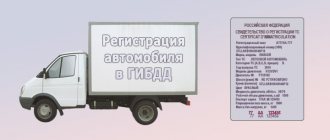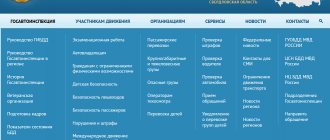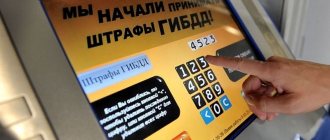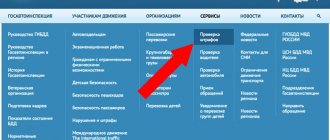A used car is always a “pig in a poke”. External well-groomed appearance and the presence of all documents do not mean anything: modern technologies make it possible to easily and quickly turn a neglected car with numerous defects into an attractive, marketable vehicle. As for documents, they are forged everywhere and en masse, and in many cases the fact of forgery can be recognized only through a complex examination.
Even when buying a car at a car dealership or autohouse, you cannot be completely sure that it:
- is legally clear;
- is not listed as stolen and is not wanted, for example, for participation in an accident;
- has no claims from customs, banking and insurance companies;
- is not under arrest or on bail;
- is not the subject of civil, judicial or other disputes;
- has no restrictions on use and alienation, as well as other encumbrances.
But currently it is possible to check a car for free using the PTS number on the traffic police website online. This service is a truly effective measure against fraud and dishonesty of sellers, and allows you to receive detailed and up-to-date information about the vehicle of interest in just a few minutes.
What is PTS and why is it needed?
A vehicle passport is a document that stores all the basic data on the vehicle, sufficient for its unambiguous identification. These include the vin code, which consists of 17 characters and is indicated not only in the title, but also on the car itself; depending on the model, it can be located on the frame, under the hood, under the windshield, etc. When buying a used car, first of all It is the VIN code that is verified.
In addition, the transport information passport indicates the make, model and color of the car, its license plate number, engine volume and number, vehicle weight, chassis number, and production date.
Before checking a car using its PTS number in the traffic police database, you need to verify the authenticity of this document. To do this, pay attention to the following features.
- Passport ornament. This is a specific pattern that should not lose clarity upon closer examination.
- Hologram. It should also be easy to read and clear. Falsification of this information is the biggest problem for scammers.
- Volumetric drawing. It is located on the back of the document, made in the form of a kind of “rose” and can be detected by touch, and also changes its color under different viewing angles.
- Watermark. It is visible in the light and represents the inscription RUS.
A vehicle passport can be issued by the vehicle manufacturer or by organizations involved in converting vehicles into special equipment, by the traffic police or by the customs service. In the latter case, you should be especially vigilant if Lithuania or Belarus is indicated as the country of origin of the car. These countries have a well-developed business in restoring vehicles after serious road accidents, as well as in assembling cars from fragments of several different cars.
What do you need to know about a copy of PTS?
You can check a car by PTS number online based on both the original and a copy of the document.
However, you should be careful when purchasing a car with a copy of the vehicle title. Using a duplicate is one of the most common schemes for selling problem cars. In particular, this is how credit cars are usually sold (since the original title in this case remains with the bank), as well as vehicles that are listed as stolen.
You can recognize a problematic credit car by a combination of the following signs:
- small age;
- low mileage;
- duplicate PTS;
- transit numbers.
Please be aware that a copy of the PTS has a structure and details identical to the original document (watermarks, three-dimensional image, etc.). The only difference is the presence of a “Duplicate” stamp in the special notes column.
As for legal cases of using a copy of a PTS, this usually occurs due to the loss of the original document, or when registration or personal data are changed. A duplicate is also issued if the vehicle passport runs out of fields intended for making entries about various registration actions. In this situation, the original document must be disposed of in the manner prescribed for such cases by current legislation.
Checking a car using PTS online
You can check your car using its title either in person at the State Traffic Inspectorate or via the Internet. The advantages of the latter option are obvious: the corresponding online services are available around the clock, the result is displayed immediately after sending the request (sometimes you have to wait a couple of minutes), the information is updated automatically. This check allows you to:
- obtain information about fines for traffic violations committed on this vehicle:
- check the information specified in the PTS;
- find out whether the car is under arrest and whether there are any restrictions on registration actions;
- check whether the car is listed as stolen;
- obtain information about road accidents committed on this car (if any).
Currently, there are several online services that allow you to quickly check a vehicle using its passport. But it is best to use the appropriate section of the traffic police website for this, since it contains the most complete, accurate and up-to-date information about vehicles. On other resources, database updates may occur with a certain delay.
What to do if the purchased car is prohibited
A preventive measure when purchasing a vehicle should be considered the operation of checking the car for a ban on registration actions, indicated above. Be sure to visit the traffic police website. Before purchasing, you need to pay attention to the history of a particular car.
To solve this problem, it is advisable to contact the seller, who is the debtor and is obliged to take steps to cancel the arrest. The inability to pay the debt on his part does not mean that measures in the form of a ban on registration are transferred to the new owner - here there is a return of money as a fact of recognizing the transaction as invalid.
It is important to know! If the previous owner refuses to take measures to repay the debt and return the money, the dispute is considered with a claim and a corresponding application in court. In this case, the court recognizes the purchase and sale agreement as concluded incorrectly and obliges the seller to return the money.
The presence in the hands of the person in respect of whose property the debt has arisen, a decision to take measures to seize a car received from a government agency, does not constitute evidence of the impossibility of registering a vehicle - often the sanction is temporary. The legislation provides for ways to challenge notices, which are expressed in correcting the reason that led to the imposition of the corresponding burden. The main thing is to check for prohibition of registration actions. Then the owner of the car should eliminate the identified violations, and then he will again be able to use the vehicle officially and at his own discretion.
Checking a car by PTS number on the traffic police website
You can check your car using its title on the traffic police website in just a few minutes. The process is carried out step by step, the service is provided free of charge, 24 hours a day, 7 days a week. Verification can be carried out based on the following data:
- vehicle chassis number;
- vehicle vin code;
- body number.
To perform the check, you need to go to the traffic police website at https://www.gibdd.ru. On the right side of the page there is a section “Online services of the traffic police” - in it you need to select the item “Vehicle check”.
Next, in the appropriate field, you need to enter the vehicle’s vin code or its body or chassis number, and then click on the “Request verification” link in the section that interests you at the moment.
After clicking the link, you will also be required to enter a verification code. After a minimum time, information about the results of the scan, including its date and time, will be displayed on the screen.
The check can be carried out repeatedly. Please note that the latest changes may not appear in the database immediately, but after a certain period of time. It is necessary to understand that scammers are trying to get rid of problem cars as quickly as possible - before they manage to get into the appropriate traffic police databases. Therefore, even if a car check according to the title shows that the vehicle is legally clean, does not have any restrictions on use/alienation, as well as claims from the traffic police and other authorities, it is recommended to carry it out again after a certain time.
In any case, it is advisable to begin re-registration of the car in the presence of its current owner.
When can you leave with a fine?
It will be possible to leave the Russian Federation if enforcement proceedings have not been initiated against the driver. Such situations are not uncommon due to the high workload of the FSSP service. As a rule, departure is not limited to persons whose fines do not exceed 10 thousand rubles.
A related factor is the absence of accidents, especially those causing damage to other road users. Sometimes, when checking the FSSP, you can see that a citizen does not have any debt. This usually happens in situations where production has not yet been started. However, there is no guarantee that this will not happen while the driver is getting ready for a trip. Then he will be detained by border guards and not released outside the country.
Advice! Thus, it is best to check for fines several times before traveling. If it turns out that the offender has not repaid the debt, you must first pay the collection, and then plan to leave.
Various penalties are applied to persons who do not comply with traffic rules. Chief among them is the fine. If it is not paid on time, the violator may be restricted from traveling abroad. In such a situation, it will be possible to leave for another country only after paying off all debts.
Check the car at the State Traffic Inspectorate
The owner can check the vehicle's title directly at the State Traffic Inspectorate. In this case, all documents for the vehicle are transferred to an authorized traffic police officer. He receives information on them from the relevant databases.
This method is considered inconvenient, since it requires spending time visiting the State Traffic Inspectorate office, standing in line, waiting for an authorized employee, etc. However, at the same time, it is recognized as the most reliable way to obtain information about a car. The information comes directly from the traffic police officer, and it is the most up-to-date. At the same time, the receipt of information on online services may take some time, and accordingly, changes may not be reflected immediately.
In some departments of the State Traffic Inspectorate, you can check your car by phone. In this case, its owner names the details of the documents for this vehicle. Some inspectorates offer the use of special applications for mobile phones.
When do you need a car title check?
Checking a vehicle using its passport is most often required when purchasing a used car. However, it may be required in other cases.
A typical example is when two or more people use one car. If one of the drivers violated traffic rules and earned a fine, he can hide this fact from his colleagues and management, and checking the car with a PTS to see if it is in the traffic police fine databases will help establish the truth in such a situation. The same applies to information about a vehicle being involved in an accident, and checking the car’s registration history will help obtain information about its unauthorized re-registration to another person.
You can also check traffic police fines on our website. Other online services are also offered, including payment for Rosreestr services, repayment of tax debts, etc.
Claiming MTPL after an accident
The package, collected certificates, and an application for compensation for damage are sent by registered mail (electronic), with a list of attachments drawn up in front of witnesses, or delivered in person. First option: if there is a lack of information or errors, the insurer is obliged to notify within 3 days. The second - right away.
The driver has the right to a PPV
Direct Damage Compensation – action through your policyholder, possible under certain conditions. Required:
- There was one culprit for the accident. Mutual fault excludes the possibility of compensation through your insurance company.
- There were no disagreements between participants.
- Only vehicles were damaged.
- No more than two vehicles were involved in the accident.
- Both drivers had an MTPL policy.
- The culprit's insurance company had a valid license.
Where to apply for damages
- Damage caused to health, property - the insurance company of the person who caused the damage (Article 12, paragraph 1 (paragraph 2) of Federal Law No. 40).
- Only the vehicle is damaged, both participants have an insurance policy, the victim turns to his insurer (Clause 1, Article 14.1 of the Federal Law of the Russian Federation No. 40).
With PPV, the victim is not limited to the right to appeal only to his company. Provided: at the time of registration he did not know that the damage was caused to health (Article 14.1, paragraph 3; 11.1, paragraph 8 (paragraph 2)), you can go to the insurer of the culprit.









